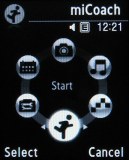Samsung F110 Adidas review: Your coach, miCoach
Your coach, miCoach
miCoach sports phone
The miCoach shortcut key below the display launches the miCoach menu. It includes items such as start, workout calendar, workouts, music player, workout photos, and settings. The music player can be accessed from here. You can pick special songs as your motivation songs - they kick in, when you start falling off your target heart rate zone during running.
Before anything else you should set up you physical profile and preferences. You should also set up the connection with the heart rate monitor and the stride sensor.
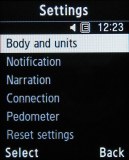
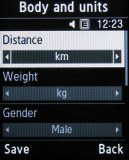
Settings menu • setting up profile and metric units
You can also set up the voice guidance system that acts as your personal coach while you are running. You can have the system read out the run stats at preset intervals or you can invoke it by tapping the phone twice. When you do that the built-in accelerometer kicks in and the miCoach voice reads out all the details that you consider important - time, distance, calories, pace, stride rate, and heart rate.
Now when it comes to heart rate, you can choose how you want it described. The system can tell you either the exact beats-per-minute or the name of the heart rate zone you are in, or even simpler - the color of the zone. There are four zones in total:
- blue or energy zone (that's 65-75% of your maximum heart rate)
- green or endurance zone (that's 75-85% of your maximum heart rate)
- yellow or strength zone (that's 85-90% of your maximum heart rate)
- red or power zone (that's 90-95% of your maximum heart rate)
Those of you that know something about running should already have an idea what running in each of these zones means. For the rest of you, well, log on to www.micoach.com and educate yourselves.
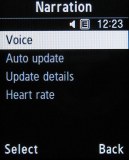
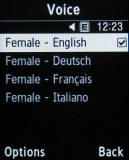
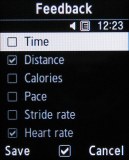

Setting up the voice guidance and feedback system
You can also choose whether the built-in pedometer in the Samsung F110 should be operating. Truth be told, it's a rather inaccurate thingy and its impact on your running stats is zilch, so you would be better off without it. The stride sensor on your running shoe will do just fine.

Setting up the built-in pedometer
Another interesting feature of the miCoach menu is the capability to create your custom workouts just like you would at the miCoach website but without the need for a computer. You create those based on preset time, distance, pace, burned calories, intervals, stride rate, or step count. Here is how an interval workout called Sprints looks like (the various colors are your target heart rate zone for the selection):



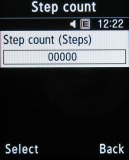
Creating several custom workouts
Now your next weapon in your miCoach arsenal is the Workout calendar. It's good to plan your workouts ahead - that usually motivates you not to miss trainings. You will see days marked with different colors - they again are based on heart rate zones colors.
The Calendar is also the place where history is found.
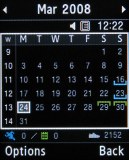
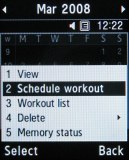
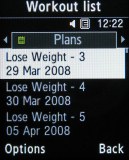

Browsing the month • calendar options • a list with your workouts: past and future • memory status
When you've finished browsing all those options, it may be high time you went running (at least that's what we did). The running interface of the miCoach system differs according to the type of workout you have chosen.
When there's a target heart rate zone that you should stick to, the interface looks somewhat like this.
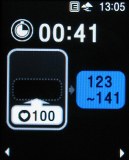
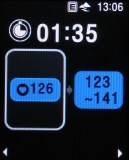
Speeding up to the Blue zone (it's more like walking actually)
If you want to see the other current stats for that run, simply press left or right on the D-pad. Unfortunately there are no sensors connected at the moment this shot was taken.

Unfortunately there are no sensors connected at this moment
If you are taking a distance-based run, such as the Assessment run for example, the interface might look something like that. There is 1.61 km to go, and none has been covered. The circle starts filling when you cover a certain distance.
As far as distance calculation is concerned, the miCoach phone uses the stride sensor. In the beginning it might seem a bit inaccurate, but after you run your first 800 m with it, it's guaranteed to catch up.
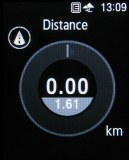
Going for the Assessment run: 1.61 km left
Now if you are to go for a free run for example, the interface also might look something like this. Now, that actually is an official photo but it should give you a clue. You can see the different colors of the heart rate zones. They change according to your current heart rate.
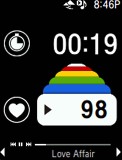
Heart rate zones are represented very well
So that's about the miCoach in general. It's all that we can show you briefly. We are sure that if you have the opportunity to work out with the Samsung F110 Adidas phone, you would find many other ways to have fun with it - just you, the track and your personal coach.
Final words
When compared to the existing digital sports systems such as the Nike+, the Adidas miCoach phone has a number of strong points - the heart-rate monitor, the free choice of running shoes, the mobile phone functionality, the "double-tap-to-get-stats" feature, and the FM radio. However, the iPod nano used by Nike has larger storage space, higher resolution display, better sunlight legibility and it's more compact.
But we are in no position to evaluate running systems, so we'll leave that to the sports blogs. As far as we are concerned, the Samsung F110 Adidas phone is a capable device, which delivers almost everything that's promised with little or no compromise.
But by just looking at its specs sheet, it's outright obvious that it's a budget model. An equivalent Samsung handset without the sports functionality would cost you 150 euro or less, while the Samsung F110 Adidas phone would presumably retail for around 250 euro without the two sensors, and around 400 euro for the full package.
Sounds a bit much for that kind of handset, but you should remember that $100 for a pair of microprocessor trainers did sound outrageous back in the 1980s too.
Successful or not, the Samsung F110 Adidas phone will remain a niche phone and you are unlikely to see much of it on phone-shop windows.
Reader comments
- Anonymous
- 10 Nov 2009
- nyE
were can i get one?
- vij
- 07 Jun 2008
- vGq
its good
- singlelayer
- 15 Apr 2008
- mpx
Great phone and definitely my next. I love it when I'm in shape and don't mind running too (it's just the getting started) and as I've let myself slip since Christmas, I can't afford not to have one!
